What a week!
Following the completion of the radio-frequency testing last week focus moved to ensuring our precious payload instruments are fit and well.
We started with the Radiation Monitoring Unit (RMU), our least known payload but which will provide very useful data of the radiation environments seen by the satellite, both for potential troubleshooting of in-orbit anomalies and more generally contribute to the overall understanding of the radiation environment in geostationary orbit.
The functional checkout was successfully completed without any anomaly.
Then came the functional testing of the Flexible Combined Imager (FCI), our cornerstone mission necessary to replace the critical service currently provided by the SEVIRI instrument on Meteosat Second Generation.
Activities started with the Calibration and Obscuration Mechanism, which is used to move filters and a shutter in front of the incoming beam during calibration and non-nominal operations to avoid direct exposure of the sensitive optics to the Sun. The tests got off to a bad start with the unlocking of the COM generating our first major instrument anomaly.
Despite all the drive currents to the pin-puller unlocking device looking good, the telemetry did not confirm a successful release. The good news is that when we switched to the redundant telemetry all was good and confirmed that the release had been successful but the microswitch on the primary side had not changed status.
For those of us who have some mechanisms experience this sadly came as no real surprise … microswitches are notoriously fickle! The good news is the COM had unlocked and functioned correctly.
The scan mechanism was then next in the firing line. The unlocking of this sensitive assembly went faultlessly and the reference scan profile was also performed without any drama, much to the great relief of Manfred Falkner (our mechanisms expert) who has lost many nights sleep during the development of this extremely complex and sensitive mechanism.
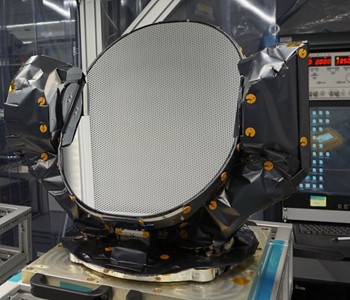
Flexible Combined Imager scan mechanism on test at SENER before delivery. (courtesy SENER)
To complete the FCI testing, an ambient electrical check of the detector assemblies was undertaken, demonstrating that all detectors had survived the transportation. This simple test replaced the more complex and time-consuming reference performance test on the detectors which require the detectors to be cooled to cryogenic temperatures (–220 Celsius) to be able to generate meaningful performance data. This test was performed in Europe a few weeks before shipment.
Finally came my favourite instrument, the Lightning Imager (LI). The team considers the LI the ‘disruptive teenager’ of the payloads, an instrument with ‘attitude’, which does what it wants when it wants!
Luckily on Thursday and Friday it was in a good mood and switched on nominally and, once we sorted out a small anomaly in the Optical Ground Support Equipment, passed its optical testing with flying colours.
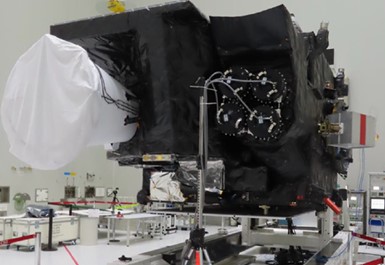
Lightning Imager with optical ground support equipment in place. (courtesy TAS-F)
This left one final check to fix, the LI’s tendency to ‘talk too much’ such that data rates generated were more than twice that expected by the satellite!
In what will forever be known as the ‘Palacios Solution’, named after our esteemed Data handling expert Alex Palacios, we managed to ‘tongue tie’ the instrument by adjusting the settings in the Data Distribution Unit, reducing the LI data rates close to that which was specified.
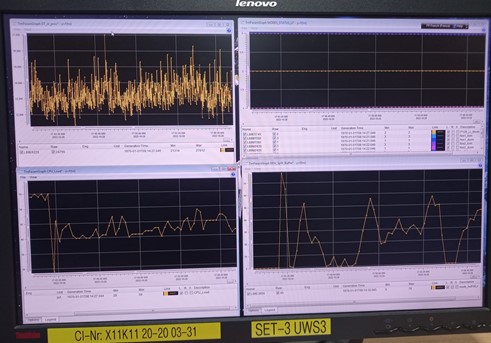
The moment of truth; a screen shot of the EGSE showing that the Palacios solution works!
So with this final test we can say the MTG-I1 payload is fit and well and ready for launch … what a satisfying week!
On Thursday the Americans came to town with the arrival of the first of their two satellites (Galaxy 35), which will be launched in the upper position on our Ariane 5 rocket.
Being a telecommunications satellite, they have a much shorter satellite preparation time before going to fuelling than MTG, just nine days.
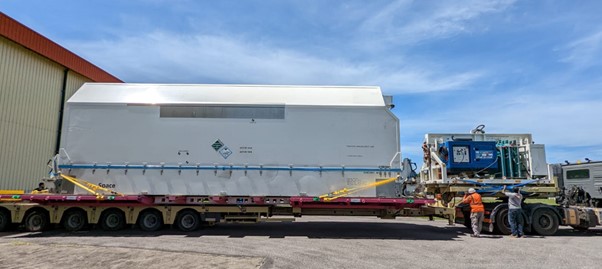
Our co-passenger Maxar Galaxy 35 arrives. (ESA)
During the arrival of the satellite it was very pleasing to see that the transport container was European provided by Beyond Gravity (aka, Ruag Space Austria, formerly Austrian Aerospace).
On the ESA team side we have been joined by the aforementioned Alex Palacios, Steph Zimmermann our ‘sparky and harness man’ and Pierre ‘the flash’ Kokou our Lightning performance man. Sadly we had to say au revoir to a very happy Donny thanks to the success of the payload testing, Alfonso (aka The Natural Born Killer) and Francesco our AIT expert who has monitored the industrial activities with an eagle eye since his arrival with the advance team. On Monday our multitalented IT support Shaf also leaves for a rest (and well needed golf lessons) being replaced by Davey Wills who is already practising his smoothy making techniques.
I am pleased to say both Francesco, Shaf and Donny will be back later in the campaign.
Another much more unwelcome arrival came with the appearance of the Ash Butterflies, which are attracted out of the jungle by the lights of Kourou. These are particularly nasty beasts as they can emit tiny needle like particles which really irritate the skin.
Several of the ESA team have already experienced this delight. We hope now that with the heavy rain over the weekend they will now disappear again, no doubt to be replaced by mosquitos!
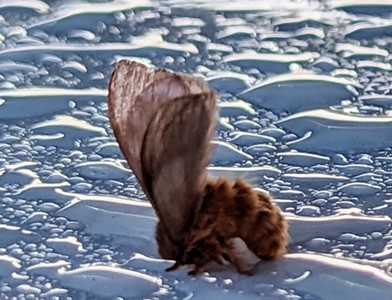
The Ash Butterfly a really anti-social visitor to Kourou! (ESA)
Thanks to the timely completion of the payload testing, the ESA, EUMETSAT and Industrial Teams have had a well-earned rest over the weekend.
Unfortunately, the weather has turned with heavy rain and wind scheduled for the next week, but this has not deterred the ESA team who on Saturday ventured out to Cayenne to visit the market with their umbrellas (very Dutch) and in a scene shamelessly copied from the film Singing in the Rain, Alex Palacios was seen swinging with his umbrella from lampposts!
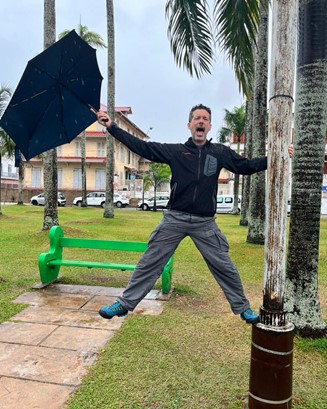
Alex fulfilling his Thespian tendencies with a rendition of Singing in the Rain! (ESA)
As well as the data handling expert, Alex is also our team photographer (Alex Paparazzios as he is now known). During the Cayenne experience he managed to snap some precious memories for the team. The first shows the team misbehaving at the Welcome to Cayenne sign, clearly enjoying themselves.
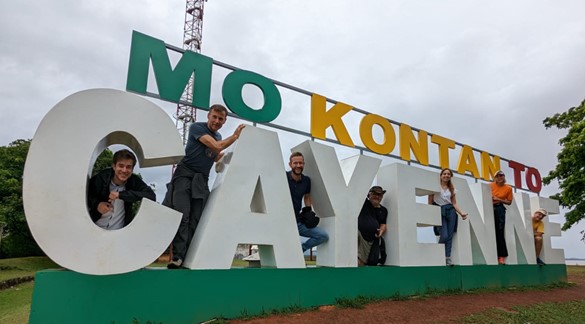
The ESA MTG support team misbehaving, again! (ESA)
He then focused on preparing a photo collection to start Raffa’s new career as a ‘senior’ male model, the target is to get Raffa ‘The Coconut’ Carli (Coco Carli for short) onto the front page of Vogue.
The first shows Raffa in ‘command mode’, on watch for marauding wildebeest, and the second at rest against a conveniently profiled palm tree.
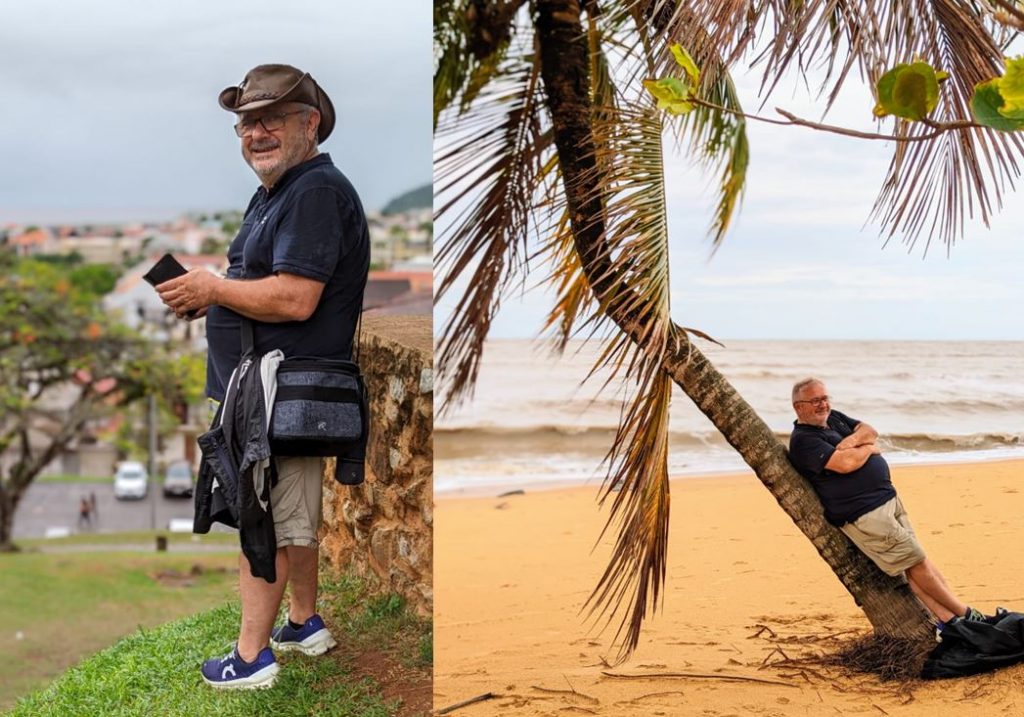
Coco Carli (the MTG Crocodile Dundee) on duty ………and at rest. (ESA)
When he vacated the tree, Manfred (our failed Austrian Hunter after his performance last week in clay pigeon shooting) decided that hunting for coconuts was more within his capabilities!! They tend not to move.

Our intrepid ‘Austrian Hunter’, Manfred, in search of coconuts. (ESA)
On Sunday we visited a church in Iracouba, with its spectacular but naïve art works done by one of the many prisoners held at the local prison back in the late 19th century.
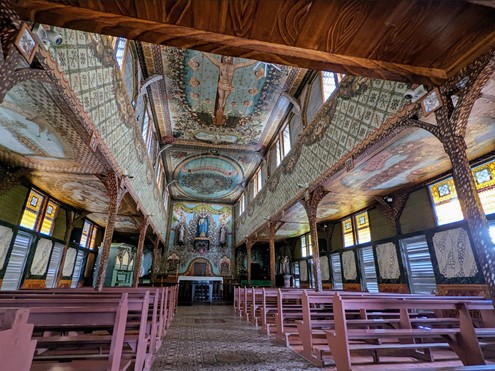
Inside the church in Iracouba. (ESA)
Also during this visit we took the opportunity to buy some exotic fruit from a local market stall. The people here are so friendly insisting we try all manner of strange looking products.

Bananas galore, plus some other very strange looking fruit, and a very friendly local vendor. (ESA)
Unfortunately, I need to finish here and prepare for the return of the ‘Duracell Bunny’ that is Martin Peccia later tonight. Also later in the week, discipline will return with the arrival of Sergeant Major Champion who really won’t like what I have done since he left ;-).
For the next instalment I will ask one (or both) of our ladies to provide a female view of the campaign so far…… keep watching.
Post from: Paul Blythe the ESA MTG Programme Manager
Read more about the Meteosat Third Generation mission.

Discussion: no comments